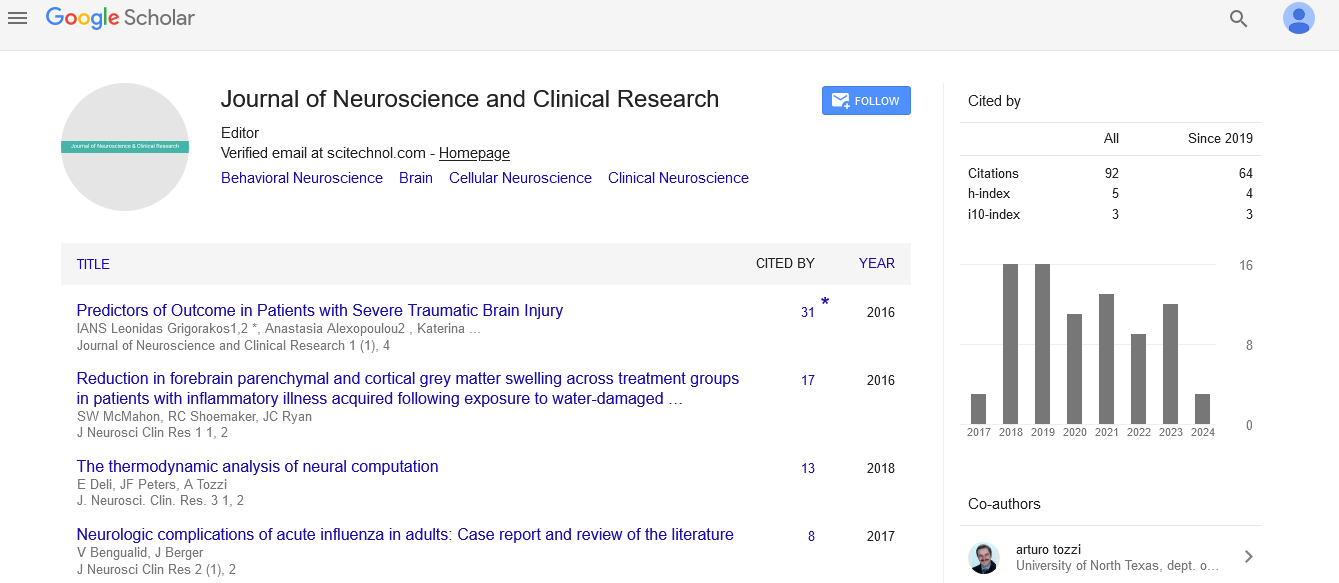Opinion Article, J Neurosci Clin Res Vol: 9 Issue: 2
Neurodevelopmental Disorders: Clinical Perspectives and Brain Research
Rubeus Hagrid*
1Department of Neurology, University of Texas Southwestern Medical Center, Texas, USA
*Corresponding Author: Rubeus Hagrid,
Department of Neurology, University of
Texas Southwestern Medical Center, Texas, USA
E-mail: ruhagrid@gmail.com
Received date: 28 May, 2024, Manuscript No. JNSCR-24-137119;
Editor assigned date: 30 May, 2024, PreQC No. JNSCR-24-137119 (PQ);
Reviewed date: 14 June, 2024, QC No. JNSCR-24-137119;
Revised date: 21 June, 2024 Manuscript No. JNSCR-24-137119 (R);
Published date: 28 June, 2024, DOI: 10.4172/Jnscr.1000195
Citation: Hagrid R (2024) Neurodevelopmental Disorders: Clinical Perspectives and Brain Research. J Neurosci Clin Res 9:2.
Description
Neurodevelopmental Disorders (NDDs) encompass a range of conditions characterized by developmental deficits that produce impairments of personal, social, academic, or occupational functioning. These disorders often manifest early in development, frequently before the child enters grade school, and are believed to be due to abnormalities in brain development. Understanding the clinical perspectives and the underlying brain research is crucial for developing effective interventions and support strategies. From a clinical standpoint, NDDs include a variety of disorders such as Autism Spectrum Disorder (ASD), Attention-Deficit/Hyperactivity Disorder (ADHD), intellectual disabilities, and specific learning disorders. Each of these conditions has unique diagnostic criteria, symptoms, and impacts on daily functioning. ASD is characterized by persistent deficits in social communication and social interaction across multiple contexts, along with restricted, repetitive patterns of behavior, interests, or activities. The clinical presentation of ASD can vary widely, ranging from non-verbal individuals with significant disabilities to those with high-functioning autism who may excel in certain areas.
ADHD is marked by a persistent pattern of inattention and/or hyperactivity-impulsivity that interferes with functioning or development. Clinicians recognize three subtypes: Predominantly inattentive presentation, predominantly hyperactive-impulsive presentation, and combined presentation. ADHD can significantly affect academic achievement, occupational performance, and interpersonal relationships. Intellectual disabilities are characterized by significant limitations in both intellectual functioning (reasoning, learning, problem-solving) and in adaptive behavior, which covers a range of everyday social and practical skills. These disabilities originate before the age of 18 and can be identified through IQ tests and adaptive behavior assessments. These disorders involve difficulties in learning and using academic skills, significantly below what is expected for the individual's age, resulting in academic underachievement. Examples include dyslexia (difficulty with reading), dysgraphia (difficulty with writing), and dyscalculia (difficulty with mathematics). The etiology of NDDs is complex, involving a combination of genetic, environmental, and neurobiological factors. Advances in neuroimaging and genetics have significantly enhanced our understanding of the brain mechanisms underlying these disorders.
Research has identified numerous genes associated with NDDs, suggesting a strong genetic component. For instance, ASD has been linked to mutations in several genes such as SHANK3, while ADHD is associated with variations in dopamine transporter genes and receptors . Neuroimaging techniques like MRI, fMRI, and PET scans have revealed structural and functional brain differences in individuals with NDDs. For example, children with ASD often show atypical brain connectivity, particularly in regions related to social communication, such as the prefrontal cortex and the superior temporal sulcus. Similarly, individuals with ADHD often exhibit reduced volume in the prefrontal cortex and abnormalities in the basal ganglia, which are involved in attention and impulse control. Prenatal and perinatal factors, such as exposure to toxins, maternal infections, and birth complications, also play a significant role in the development of NDDs. Studies have shown that early intervention can mitigate some of the impacts of these environmental risks.
Understanding the brain's capacity for neuroplasticity-the ability to reorganize itself by forming new neural connections-has opened new avenues for interventions. Early and targeted interventions can leverage this plasticity to improve outcomes for individuals with NDDs. Behavioral therapies, educational interventions, and pharmacological treatments are tailored to address specific deficits and enhance adaptive functioning.
Conclusion
The interplay between clinical practice and brain research is vital for advancing our understanding of neurodevelopmental disorders. Continued research into the genetic, neurobiological, and environmental underpinnings of these conditions will not only enhance diagnostic accuracy but also pave the way for more effective and personalized interventions. As our knowledge grows, so does our ability to support individuals with NDDs, helping them achieve their full potential and improve their quality of life.
 Spanish
Spanish  Chinese
Chinese  Russian
Russian  German
German  French
French  Japanese
Japanese  Portuguese
Portuguese  Hindi
Hindi 